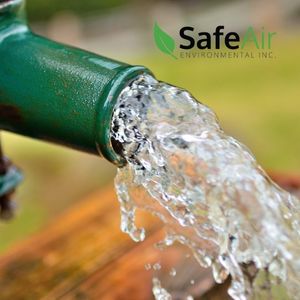Is Well Water Causing an Indoor Air Quality Risk
Posted in Radon Testing, on March 14, 2023
Radon detection for your home or country property is one of the best things you can do to improve indoor air quality and long-term health and safety. While you might know about some of the common radon gas risk factors, like foundation cracks, location, or piping, the SafeAir team wants you to consider radon testing if your home uses well water. One of the lesser-known causes of radon gas indoors, well water can spread this odourless and tasteless gas throughout your home — increasing your cancer risk and compromising indoor safety.
How Does Radon Enter Through Wells?
 When your home’s water supply comes from an aquifer and not a municipal one, the water may not be correctly vented and may hold on to gasses like radon or methane. When water and air mix (such as through bathing, cooking, or running the tap), the gas and water molecules separate, releasing these gasses into your indoor air environment.
When your home’s water supply comes from an aquifer and not a municipal one, the water may not be correctly vented and may hold on to gasses like radon or methane. When water and air mix (such as through bathing, cooking, or running the tap), the gas and water molecules separate, releasing these gasses into your indoor air environment.
Where is Radon Most Likely To Accumulate?
Radon gas tends to accumulate on lower levels of people’s homes — in urban environments, this is usually the basement or crawlspace, since these spaces tend to have a greater concentration of traditional radon gas entry points. But homes using well water may have significant differences from city homes, such as no basement, different styles of foundation, or aging or older architectural features, including piping and wastewater systems. These differences can become ground-floor or bedroom-level entry points for radon gas in well water.
How to Detect Radon in Your Well and Home
Radon detection is the only way to know if this invisible gas affects your home. At SafeAir, we’ve helped thousands of families in urban and rural areas monitor and test their homes for radon gas. Our non-invasive and passive radon testing takes place over 3-6 months using a small device that’s carefully installed in your home. After the testing period is complete, we remove the device and send it to a third-party lab for analysis, after which we share the results with you — and any radon reduction strategies you may need to take.
How to Get Radon Out of the Well
The good news is that radon gas in well water is relatively easy to remove. Because the gas and water separate when they meet, a simple aeration device at your well is often all that’s needed to encourage this natural reaction before the water enters your home.
What is the Risk of Radon?
Next to cigarette smoking, radon gas is the leading cause of lung cancer in Canada. When you have radon gas in your well water, the risks for stomach cancers and other diseases may also increase because the water releases radon every time you cook, bathe, wash clothes, and turn on the tap.
SafeAir has been doing radon tests in the GTA for over a decade and has helped families reduce and eliminate their risks through easy and discreet testing. To have us visit your home for radon detection, reach out online or by phone to learn more.

